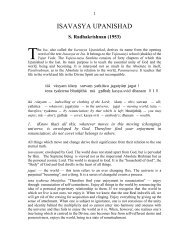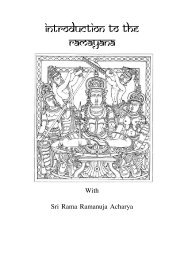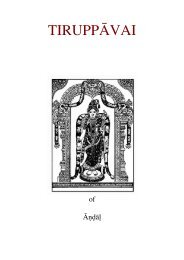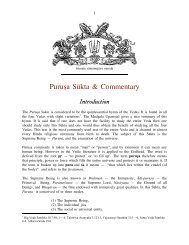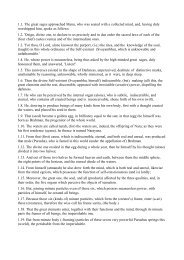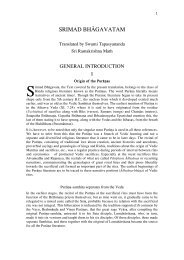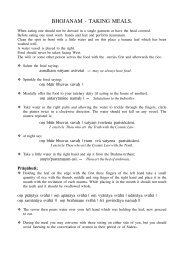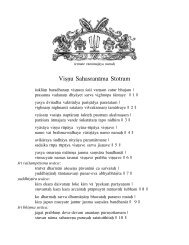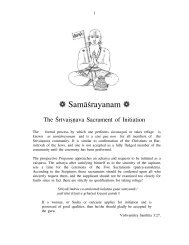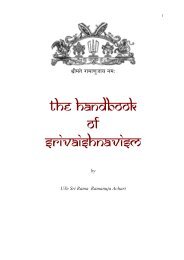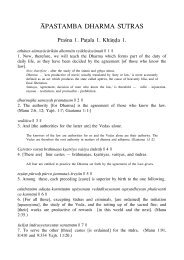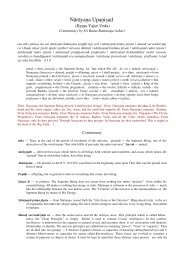Sri Vaishnava Guru Parampara - Yajur Veda Australasia - Resources
Sri Vaishnava Guru Parampara - Yajur Veda Australasia - Resources
Sri Vaishnava Guru Parampara - Yajur Veda Australasia - Resources
- No tags were found...
You also want an ePaper? Increase the reach of your titles
YUMPU automatically turns print PDFs into web optimized ePapers that Google loves.
<strong>Sri</strong>:<strong>Sri</strong> Ramanuja at <strong>Sri</strong> Perumbudur<strong>Sri</strong> <strong>Vaishnava</strong> <strong>Guru</strong> <strong>Parampara</strong>(Exalted Oran-Vazhi Lineage of Teachers)Vedics Foundation: http://www.vedics.netSUGGESTED DONATION: $Y.YY
2Achaarya Lineage1<strong>Sri</strong>dhara(<strong>Sri</strong>manNarayana)2<strong>Sri</strong> (Maha Lakshmi)3Vishvaksena4Sattakopaya5Nathamuni6Pundarikaksha7RamaMisra8Yamunacharya9MahaPurna10<strong>Sri</strong> Ramanuja9Embar8ParasaraBhattar7NanJeeyar6Nampillai5Vadakku-ThiruvidhiPillai4PillaiLokacharya3ThiruvaiymozhiPillai2Manavala Mamuni1<strong>Sri</strong>dhara(<strong>Sri</strong>manNarayana)
3<strong>Sri</strong>:<strong>Sri</strong>mathe Ramanujaya Namaha:<strong>Sri</strong>math Varavara Munaye Namaha:VEDICS PUBLICATIONVedics Foundation (http://www.vedics.net)Table of ContentsOur Acharyas 4Picture: Necklace of our Acharya Lineage 9<strong>Sri</strong> Visvaksena 10<strong>Sri</strong>man Nathamuni 11<strong>Sri</strong> Uyyakondar 13<strong>Sri</strong> Manakkal Nambi 14<strong>Sri</strong> Parasara Bhattar 15<strong>Sri</strong> Nanjeeyar 18<strong>Sri</strong> Nampillai 21<strong>Sri</strong> Vadakku Thiruveedi pillai 25<strong>Sri</strong> Pillai Lokacharya 26Swami Manavala Mamunikal at Sikkil Kidaaram
Our acharyasThe srIvaishNava AchArya guruparampara is our greatest gift. Meditating upon the salutations to our AchAryAsremind us of their greatness, as well as the qualities that they had, and indirectly this reminds us of the kind ofqualities that one needs to aspire to have.The following are the salutations to the lineage of teachers right from the Lord srIman nArAyaNa himself all theway to srI maNavALa mAmunigaL. The Lord Himself considers srI maNavALa mAmunigaL to be his AchArya(evidenced by the salutation, that was composed by ranganAthA himself). Hence, the lineage completes a fullcircle with the Lord at the top of the list, and the circle completed by the relationship between the Lord andsrI maNavALa mAmunigaL.The lineage is as follows:1. srIman nArAyaNa (Lord ranganAtha)2. srI ranganAyakith thAyAr3. srI viSvaksEna4. srI nammAzhvAr (srI saTakOpa)5. srIman nAdha muni6. srI puNdarIkAkshar (srI uyyakkoNdAr)7. srI rAma miShra (srI maNakkAl nambi)8. srIman yAmuna muni (srI AlavandhAr)9. srI mahApUrNa (srI periya nambi)10. srI rAmAnuja (emperumAnAr)11. srI embAr (srI gOvinda bhattar)12. srI parAsara bhattar (11a. srI kUrattAzhvAn)13. srI nanjIyar14. srI nampiLLai15. srI vadakku-th-thiruveedhip piLLai16. srI piLLai lOkAchAriAr (15b. srI periyavAchchAn piLLai)17. srI thiruvAymozhip piLLai18. srI maNavALa mAmunigaL19. back to Lord ranganAthaNote: srI. kUrattAzhvAn and srI periyavAchchAn piLLai are in the literal sense, not part of the guruparamparalineage. However, many elders have included their salutations too in the lineage, given their stature andprominence. Given the goal of reciting/meditating upon the guruparampara, the more AchAryAs that we canmeditate upon, the better for us. Hence, the two salutations are included.Every day, our AchAryAs advise us to medidate upon our guruparampara. In many cases, one’s directguruparmpara does not go through the lineage as mentioned above, and usually branches after rAmAnuja.Especially for descendants and/or shisyAs of the 74 simhAsanAdhipathis established by rAmAnuja, theguruparampara will start with the current AchAryan, his AchAryan, his AchAryan and so on till it reachesrAmAnuja, and after that, it is common for everyone. For example, for descendants and/or followers of one ofthe branches of the thirumalai anandAnpiLLai AchArya purusha family (that are descendants of ananthAzhvAn),the AchArya parampara goes through srI thirumalai anandAnpiLLai krisNhamAchAriAr (current AchArya), hisAchAryA and so on, till srI anantAzhvAn, then srI aruLAlap perumAL emperumAnAr, and then rAmAnuja, thenperiya nambi, AlavandhAr and so on till perumAL.1
In such cases, elders suggest the following1. do the meditation of the guruparampara in the ascending and descending order2. for the descending order, meditate/recite in the order as given below - i.e. perumAL throughemperumAnAr through maNavALa mAmunigaL3. for the ascending order, meditate upon one’s immediate AchAryA, His AchArya, and so on tillemperumAnAr, and then follow the common path (i.e. periya nambi, AlavAndhAr etc.. through perumAL)We hope that you find the following useful in remembering our great AchAryAs. If you find any mistakes in thetransliteration, please inform us so that we can correct the mistake.!rgfknatrf!sftnap 4 r]mf Etj@ !rgfEk 3 Symf ~SfrEy |cinftam]imiEvatf 3 p 4 anftmf utfsgfEk 3 `nnft Ep 4 aki 3 n@ ||srI ranganAtharsrI sthanABharaNam thEja: srIrangESayam AsrayE |chinthAmaNimivOdhBhAntham uthsangE anantha BhOgina: ||()!rgfknayki (epriy piradfF)nm@ !rgfk 3 naykfAy ytf 3 pf 4 Yrvipf 4 rm Ep 4 tt@ |:ESSitvfy Avxmfy nimfEnanfntmit 3 mf jk 3 tf ||srIranga nAyaki (periya pirAtti)nama: srIranga nAyakyai yadhBrUviBrama Bethatha: |ISESithavya vaiShamya nimnOnnathamidham jagath ||viSfvkfEsnrf!rgfk cnftirmsminftirya vihrftfTmf vinfysfy visfvcitcinfnynatikarmf |2
Eya nirfvhtfy nismgfKli MtfrAyv EsnanfymnfyviMkasftm cicfriyam ||vishvaksEnasrIranga chandiramasa mindirayaa viharththum vinyasya visvachidhacinnayanAdhikAram |yO nirvahathya nisa manguli mudrayaiva sEnAnyamanyavimukhAsthama sisriyAma ||nmfmazfvarfmata pita y4tisf srfvmf yEt 3 v niyEmnmt 3 nfvyanamf |~tf 3 ysfy n@ KlpEtrf vKqapi 4 rammf !mtf tt 3 gfriy
! u yfykfeka]fdarfnm@ pgfkj Entfray nat 2 !pat 3 pgfkEj |nfysffytf srfvp 4 rayasfmtf Klnat 2 ay tI 4 mEt ||srI uyya-k-koNdArnama: pankaja nEthrAya nATha: srI pAdha pankajE |nyasyath sarva BarAyAsmath kulanAThAya DhImathE ||()! m]kfkalf nmfpi 4`ytfnEta yaMnmatfmt 3 asmf `qrfkfk ptfrarfp] nixfkfrEy] |y@ kfrIt vanasfti 2 t eyqvrajfymf nmami tmf rammEmy stfvmf ||srI maNak-k-Al nambiayathnathO yAmunamAthmadhAsam aLarkka pathrArpaNaniShkrayENa |ya: krItha vAnAsThitha yauvarAjyam namAmi thamrAmamamEya sathvam ||()! ~qvnft 3 arfytf 3 pt 3 amfEp 4 aRhtf 4 yan vitf 4 vsftaESx klfmx@ |vsfTtaMpyaEtahmf yaMEnymf nmami tmf ||srI AlavandhAryadh padhAm BoruhaDhyAna viDhvasthASESha kalmaSha: |vasthuthAm upayAthOham yAmunEyam namAmi tham ||()4
! epriy nmfpi 3kmlapti klfya] K 3 ]amfRt niExvya |p>rf]kamay sttmf p>rf]ay mhEt nm@ ||srI periya nambikamalApathi kalyANa GuNAmrutha niShEvayA |pUrNa kAmAya sathatham pUrNAya mahathE nama: ||! ramaNjrfEyanitfymf `cfy
srI kUraththAzhvAnsrI vatsa chinha miSrEBhyO nama ukthi maDhImahi |yadhukthayas thrayIkaNTE yAnthi maNgaLa sUthrathAm ||! praSr p 4 dfdrf! praSr p 4 df 2 d 2 arfy@ !rgfEk 3 S p4yEs ||srI parAsara bhaTTarsrI parAsara bhaTTArya: srIrangESa purOhitha: |srI vatsAnkasutha: srImAn srEyasE mEsthu BhUyasE ||! nwfjIyrfnEma Evt 3 anft Evtf 3 yay jk 3 nf mgfk 3 q EhtEv |ysfy vak 3 mfRtasarp>ritmf prmkf 3 rfymf |~t 3 ay vrfxnftmhmf pfrptf 3 EykaR]fyp>rf]mf kli^vrit 3 asmf ||srI nampiLLai6
vEdAnta vEdyAmrtha vAri rASE:vEdArtha sArAmrutha pUramgryam |AdAya varshanthamaham prapadhyEkAruNya pUrNam kali vairi dAsam ||vdkfKtftiRvItipf piqf^q! kfRxf] pat 3 pat 3 apf 3 Ej nmami Sirsa st 3 a |ytf pfrsat 3 pfrp 4 aEvn srfv sitf 3 ti 4 rp>4nf mm ||vadak-k-kuth thiruvIdhip piLLaisrI krshNa pAda pAdAbjE namAmi SirasA sadA |yath pradAdapraBhAvEna sarva sidDhiraBhUn mama ||! epriyvacfca[f piqf^q!mtf kfRxf]smahfvay nEma yaM[ sHnEv |ytf kdaAXk lXfya]amf sJlp 4 @ !t 4 rsf st 3 a ||srI periyavAchchAn piLLaisrImath krshNasamAhvAya namO yAmuna sUnavE |yath katAkshaika lakshyANAm sulaBha: srIdharas sadhA ||! piqf^q ElakacariyarfElakacarfy K 3 rEv kfRxf]pat 3 sfy sJnEv |smfsar Ep 4 aki 2 snft 3 xfd jIvjIvatEv nm@ ||srI piLLai lOkAchAriArlOkAchArya guravE krshNapAdasya sUnavE |samsAra BhOKi sandhaShta jIvajIvAthavE nama: ||7
! tiRvayfemazipfpiqf^qnm@ !Aslnat 2 ay KnftI nk 3 r j[fmEn |pfrsat 3 lpf 3 t 3 prmpfrapfy Akgfkrfy SaliEn ||srI thiruvAymozhip piLLainama: srISaila nAThAya kunthI nagara janmanE |prasAdhalabdha parama prApya kainkarya SalinE ||! m]vaq maM[ikqf!ASElS t 3 yapatfrmf tI 4 p 4 kftfyati 3 K 3 ]arf]vmf |ytInftf 3 pffrv]mf vnfEt 3 rmfy jamatrmf M[imf ||srI maNavALa mAmunigaLsrIsailEsa dayApAtram DheeBhakthyaadhi guNaarNavam |yatIndrap pravaNam vandhE ramya jAmAtaram munim ||<strong>Sri</strong> Ramanuja is the main jewel in our Acharya Lineage. All <strong>Sri</strong> <strong>Vaishnava</strong>s, by having a connection to <strong>Sri</strong> Ramanuja, arelinked to God as their first Acharya. The lineage is represented as a necklace of precious gems. It starts with Ramanujaas the central jewel of the pendant among teachers and connects to first Acharya, who is the Lord Himself.Uniqueness in all the Acharyas messages is they all speak with one voice, all their works will support one another andare true to the <strong>Veda</strong>s – samskrit vEda and the tamizh vEda. Swami maNavALa mAmunikaL is chronogically the last ofthe set of AchAryAs known as “poorvAchAryAs” – the primary AchAryAs, or the earlier AchAryAs. The Achaaryaparapmara is completed by Lord himself when He symbolically took srI maNavALa mAmunikaL as HIS own Acharya.Thus, The AchArya <strong>Parampara</strong> starts and ends with the LORD himself. The fist page shows the depiction of the abovelineage in a nice garland.8
Achaarya Lineage1<strong>Sri</strong>dhara(<strong>Sri</strong>manNarayana)2<strong>Sri</strong> (Maha Lakshmi)3Vishvaksena4Sattakopaya5Nathamuni6Pundarikaksha7RamaMisra8Yamunacharya9MahaPurna10<strong>Sri</strong> Ramanuja9Embar8ParasaraBhattar7NanJeeyar6Nampillai5Vadakku-ThiruvidhiPillai4PillaiLokacharya3ThiruvaiymozhiPillai2Manavala Mamuni1<strong>Sri</strong>dhara(<strong>Sri</strong>manNarayana)9
SRI VISVAKSENA<strong>Sri</strong> VisvaksEna, in the divyadEsam of thiru-alli-k-kENiSalutation (thaniyan):tulAkathEthi nagarE poorvAshAdA samudhbhavampadmApadhAmbhujAsaktham sEnAdhipamaham bhajE<strong>Sri</strong>rangachandiramasa mindhirayA viharthumvinyasya vishva chitha chinnayanAdhikAram !yO nirvahathya nisamanguli muthrayaivasenAnyamanyavimukAsthama sisriyAma !!srI visvaksEna (in tamizh, sEnai mudhanmaiyAr) is the commander in chief of the Lord’s army. He is consideredas the sishya of <strong>Sri</strong> mahAlakshmi (by virtue of his place in the Acharya lineage), and the acharya of srI SatakOpa(nammAzhvAr). Our Lord, <strong>Sri</strong>man nArAyaNa, the king who rules over all the sentient and insentient beings isconsidered to be under the control of the dhandam (stick in the hand) of visvaksEna (like a President/Primeminister, who is under the control of his ministers, and the chief of staff of the army). This doesn’t mean that theLord is ruled over by visvaksEna. The Lord has handed over the responsibility of running the day to day activitiesof the universe to visvaksEna, and thereby has confidence in him to take all decisions. Our teachers explain thisconcept in a very beautiful style (in tamizh, rasam). TheLord and His consorts (srI dEvi, bhU dEvi, nILa dEvi)are present in the private courtyard that they normally spend time in. Suddenly, without any notice, visvaksEna(who is a old person), enters the courtyard. The consorts of the Lord are taken aback, and they hide themselvesunder the cot. Our teachers point this out and say that even the Lord and His consorts give abundant respect toHis elderly person (visvaksEna) who takes care of all the issues in His kingdom (which is this universe).Among all the nithyasUris (ever-liberated souls), srI visvaksEna is the first. In every major temple, there is asanctum sanctorum for visvaksEna, and an idol of visvaksEna. Before the Lord goes out (in ceremonialprocession), visvaksEna goes ahead of time in the same route that the Lord will take, and inspects the route tomake sure that they are “safe” and fit for the Lord to take. He is the prime representative of the Lord in all10
occasions. He is found with 4 hands {caturbhuja form – 4 hands containing the shanka, charka, dhanda and thefourth hand showing the sign of wisdom (jnAna mudra) }.Our teachers teach us that it is srI visvaksEna who taught the deep esoteric concepts (rahasyArtha) of our religionto srI nammAzhvAr.srI visvaksEnA’s appearance day is in the tamizh month of aippasi (thula, in sanskrit), the star of pooraadam(uttara aashaada)The slOka that we all recite before chanting vishNu sahasranAmam –“yasyath viradha vakrAthyA: pArishadyA: parassadham !vignam nignanthi sadhatham vishvaksenam thamAsrayE !!”is in fact a prayer to srI visvaksEna to remove all the obstacles that hinder our path of thinking about the Lord.Prior to most rituals (family rituals like entering a new house, or rituals in the temple like the holy bathing of theLord), a ritual worship (ArAdhana) is done to srI visvaksEna so that all obstacles to the performance of the mainritual are removed.<strong>Sri</strong>man NATHAMUNISalutation:Vyomna: Parasthath savitham samethyaLakshmya nyogath kurukathiraja:SamanthraRajathvayaMaha yasmaiNathaya thasmai munaye Namosthu”Nathamuni ( Courtesy <strong>Sri</strong>matham.com)“namO achintya adhbutha akliShta jnAna vairAgya rASayEnAdAya munayE agaadha bhagavad bhakti sindhavE”11
The following are excerpts from two common slOkAs that we recite everyday:“lakshmI nAdha samArambhAm nAtha yAmuna madhyamAm” (With the consort of Lakshmi in the beginning,and srI nAthamuni and yAmuna muni in the middle”“nAthO pajzam pravrutham bahupir upAsaitham yAmunEyaprapanndhai:Thratham samyak yathinrairitham akila thama: karsananum num”The above two slOkAs state that srIman nAthamuni occupies a central role in the spread of the srIvaishNavasampradAya. Even though the srIvaishNava religion has existed from time immemorial, it has become prevalentamong many people only after srIman nAthamuni – this is said by svAmi vEdAnta dEsika “nAthOpajzampraviruththam”, and srI maNavALa mAmunikaL – “aruL peRRa nAthamuni mudhalaam nam dEsikarai allaalpEdhai manamE uNdO pEsu” {oh confused mind! Is there a lineage of AcharyAs other than the one which startsfrom srIman nAdhamuni?}srIman nAthamuni was born in veera nArAyaNa puram (present day kAttu mannAr kOvil, near chidambaram intamilnadu) to srI Isvara muni, who was the priest at the local temple for the Lord. srI Isvara muni named his sonas srI ranganAtha. At the proper age, young ranganAtha was initiated into learning the vEdAs, and proved to bean accomplished learner. He helped his father Isvara muni in performing service at the local temple.One day, both the father and son took leave of the presiding deity of the temple (srI mannAr), and left for apilgrimage of holy places north of veera nArAyaNa puram. They went to places like srI mathura, vrindAvan, theyamuna river bank, srI gOvardhana giri, srImad dvAraka, ayOdhyA, sALagrama and badrinath. They lived on thebanks of yamuna, doing service to the Lord of the yamuna river bank – yamuna-i-th-thuraivan. One day, srImannAr (the presiding deity at their homeplace) appeared in their dream and asked them to come back to Him.So, they took leave of the Lord of the yamuna banks, and after pilgrimage of places ahObilam, ghatikAchalam,kAchipuram and srIrangam, returned to their hometown. At their hometown, they performed service at the Lord’stemple by lighting lamps, making garlands and singing sweet songs about the pastimes of the Lord.One day, as srI ranganAtha was attending to his services, a group of srIvaishNavAs from the western land(mElukOte) came to worship the Lord, and sang 10 songs. The first song started with the word “ArA amudhE” –“Oh! My limitless nectar!”. These 10 songs were incredibly beautiful and thoughtful, and the last song had thephrase “Or AyiraththuL ip-paththum” – these 10 songs among the 1000. Moved by the songs, and curious aboutthem, srI ranganAtha (srI nAthamuni) asked the srIvaishNavAs if they knew the 1000 songs, and who composedthem. He wanted to learn all the 1000 songs from them. The srIvaishNavAs replied “Unfortunately, we do notknow any more than these 10 songs. We also do not know of anyone who knows all the 1000. These songs havebeen given to us by our forefathers, and we keep reciting them”, and they left for the next holy place.After this incident, srI nAthamuni was always immersed in thought about these songs. Suddenly, one day, herealized that there was a word “kurukoor sadagOpan” in the last song, and maybe if he goes to the place kurukoor,he might get more answers. He took leave from the deity of the temple, and reached thiru-k-kurukoor (present dayAzhvAr thirunagari, near thiru-nel-vEli, in south tamizhnAdu), and paid his respects to the Lord at the templethere – polindhi ninRa pirAn – “The Lord who gives out radiance”. A person by the name of srI parAnkusa dAsahappened to be there. srI nAthamuni asked him about the songs that he had heard. srI parAnkusa dAsa, who wasborn in the lineage of a great devotee of nammAzhvAr, the foremost of all devotees of the Lord, replied “Thesesongs are part of thiru-vAy-mozhi. Thiru-vAi-mozhi and other holy compositions were lost a long time ago.There is noone who knows them. But, we know the 11 poems of a work called kaNNi-nun-ciRuth-thAmbu.Elders say that if someone learns these 11 poems, and recites them 12,000 times with great devotion andmeditation, that person may get the grace of nammAzhvAr.” On hearing this, srI nAthamuni became ecstatic, andwith tear filled eyes requested srI parAnkusa dAsa to teach it to him. srI nAthamuni, after learning went the shade12
of a tamarind tree (the same tree, under which srI nammAzhvAr lived when he was on this earth), and recited thesongs 12,000 times with deep devotion. When he completed reciting them, a voice echoed from the heavens“What do you desire”?. srI nAthamuni immediately realized that it was the voice of srI nammAzhvAr, and said“svAmi! Please give us back thiru-vAy-mozhi and other holy compositions” with great veneration. svAminammAzhvAr took great delight at this request, and through divine powers taught srI nAthamuni not only theholy compositions (divya prabhandham), but also esoteric concepts (rahasyArthAs), the ashtAnga yOga techniquesand its meanings.srI nAthamuni resided in thiru-k-kurukoor for a while, and then left for veera nArAyaNapuram. There, he taughtthe holy compositions to key disciples, and set them to music and dance. This great tradition of singing the holycompositions with dance and music continues to this day at major temples. It is very accurate to say that withoutsrIman nAthamuni, we will NOT have the great wealth of knowledge we have. Can one even imagine a situationwhere we do not have these holy compositions?srI nAthamuni had 11 prominent disciples. They were – srI uyya-k-koNdAr, thiru-k-kurugai kAvalappan, srIpiLLai karuNakara dAsar, nambi karuNAkara dAsar, Eru thiru udaiyAr, thiru-k-kaNNamangai ANdAn,vAnamAmalai deivanAyaka ANdAn, uruputtUrAr Achchan, sokaththu AzhvAn, keezhai agaththu AzhvAn andmElai agaththu AzhvAn.He also blessed us with the following works – nyAya tattva sAram, yOga rahasyam and Purusha nirNayam.Unfortunately all the above works are non-existent today.Salutation:<strong>Sri</strong> UYYAKONDAR“NamasyAm Aravindhaksham Nathabhave VyavasthithamSudhdhasththvamayam SowreravathAramivaparam”Namah: pankaja nEthraya Natha <strong>Sri</strong>pAda PankajENyastha SarvaparAyAsmath kulanaadhaaya DhimathE”Life history:Very little is known about the life history of srI uyya-k-koNdAr, also called srI puNdarIkAksha. What is known isas follows.srI uyya-k-koNdAr was anointed as the leader of all devotees by srIman nAthamuni. After srIman nAthamuni leftfor the abode of the Lord, srI uyya-k-koNdAr continued to reach the great concepts (the esoteric meanings, thethiruvAymozhi etc.) to his disciples who included srI rAma miSra (srI maNakkAl nambi). It is known that heanointed srI maNakkAl nambi as the next preceptor. Also, srI uyya-k-koNdAr predicted that a son would be bornto srI Isvara Bhattar (another disciple who also happens to be the son of srI nAthamuni), and that this son shouldbe named after the Lord of the banks of the river yamuna - yamunai-th-thuraivan.srI uyya-k-koNdAr’s place of birth is thiru-veLLarai, a place near srIrangam. He was born on the day of the starkriththika, in the month chaitra. The other names by which he is referred to are – padmakAksha, rajIvAksha andaravindAksha. His prominent disciples were srI maNakkAl nambi, thiru-alli-k-kEni pAn perumAl araiyar, chEtlUrsendAlankAradAsar, kOmadam thiruvinnakappan and ulagaperumAL nangai.13
<strong>Sri</strong> MANAKKAL NAMBISalutation:“Anujjitha ZhaMayogama punya JanapadhakamAsprushtamatha ragam tham Ramam dhurya mupAsmahe”“Bhagavad bhakthi dhukThapthi krthaKadAvaKA hanamNimuktha Thapathrithayam <strong>Sri</strong>Ramam Saranpa saraye”“ayathnathO yAmunam Athma dAsam, aLarka patrArpaNanishkrayEnaya:kreethavaan aasthitha yowvarAjyam, namAmi tham rAmam amEyasaththvam”Life History:svAmi maNakkAl nambi was one of the prominent disciples of srI uyya-k-koNdAr. For 12 years, just aslakshmaNa was serving rAma, srI maNakkAl nambi served srI uyya-k-koNdAr. Especially after srI uyya-kkondAr’swife passed away, srI maNakkAl nambi took care of all the household activities at his house. Thisincluded taking care of the two little daughters of srI uyya-k-koNdAr. One day, srI maNakkAl nambi wasescorting the two little girls from their playground to the house. There was a fairly large puddle of water that thegirls could not cross without getting their feet muddy. They were hesitating to cross the puddle. On seeing this, srImaNakkAl nambi lay down, with outstretched hands across the puddle and asked the two small girls to walk on hisback so that they wil not get dirty. When they reached home, srI uyya-k-koNdAr first saw the two children. srImaNakkAl nambi was inside the house, doing some chores. srI uyya-k-kondAr asked the girls how they managedto get home without getting their feet muddy as there was so much water left from the rain in the past two days allover the place. The children told him what had transpired. srI uyya-k-koNdAr immediately summonded srImaNakkAl nambi and gently chided him for doing this. He also was so pleased with srI maNakkAl nambi that hetaught the esoteric meaning of one of the most important slOkAs in our religion (the dvaya mantra) to him again.After srI uyya-k-kondAr passed away, srI maNakkAl nambi took over the leadership of the devotees, and taughtall the esoteric meanings and the holy compositions to his disciples. As predicted by srI uyya-k-koNdAr (and srInAthamuni), a son was born to srI Isvara muni in the month of aadi in the star of uththarAdam. SrI maNakkAlnambi named the baby as “yamunai-th-thuraivar” (later came to be known as yAmunAcharya).srI yamunai-th-thuraivan was educated in the proper sAstrAs and the various branches of spiritual knowledge(vEdAs), and got married at the proper time. Later, he was given half the kingdom (of the place where he wasresiding), and was given the name “ALavandhAr” – the one who came to rule. This incident in his life history willbe elaborated upon in the section on srI ALavandAr. He started to rule the kingdom, and generally took littleinterest in spiritual activities.srI maNakkAl nambi learned about this, and became sad. srI nAthamuni, and srI uyya-k-koNdAr had passed on tosrI maNakkAl nambi the great wealth that is the srIvaishNava religion, and srI yamunai-th-thuraivan, though hewas the grandson of srI nAthamuni, was not bothered about this great wealth at all. srI maNakkAl nambi went tothe palace to meet the young king, and was not allowed to go near the king. Undeterred, he inquired the kitchencooks as to what the most favourite dish of the king was. They mentioned that the king liked a green calledthUduvaLai (a local green with medicinal properties). srI maNakkAl nambi started to bring this green every day,and the cooks cooked them for the king. This happened for a few months, and suddenly srI maNakkAl nambistopped giving the greens. After four days of food without his favourite green, the king – yamunai-th-thuraivanasked the cooks what the matter was. The cooks said that an elderly scholar brought them without fail for the past14
few months, and suddenly stopped bringing them. The king told that the next time the elderly person comes, hewanted to see him, and ordered the cooks to bring the elderly person to him if he comes. After a few days, srImaNakkAl nambi brought the green again. This time, the cook took them to the king. The king asked “Why wereyou bringing this for a few months? Is there anything you need from me?”. srI maNakkAl nambi replied – “I donot need an wealth from you. I know about the wealth that was handed over by your forefathers. I know where itis hidden, and would like to give it back to you”. Yamunai-th-thuraivan was surprised to hear this, and asked srImaNakkAl nambi about the wealth. srI maNakkAl nambi replied that he had to teach it to yamunai-th-thuraivanover some time. He stayed in the palace, and taught the 18 chapters of srI bhagavad gIta to yamunai-th-thuraivanalong with its meanings. After this, he felt that yamunai-th-thuraivan was ready to receive the crown jewel of all thewealth. He took the young king ot <strong>Sri</strong>Rangam, and showed him the beautiful Lord who resides there. On seeingthe Lord, yamunai-th-thuraivan was moved to tears, and he cried “I have wasted so many years”. He stayed backin srIrangam, and learnt the wealth (all that was taught by srIman nAthamuni to his disciples which was passedalong to srI uyya-k-koNdAr and srI maNakkAl nambi) from srI maNakkAl nambi.When he was ready to leave this earth for the abode of the Lord, srI maNakkAl nambi told yAmunai-th-thuraivan(who had, by now taken the path of ascetics, and was widely known as srI ALavandAr) – “ “You, who is related to<strong>Sri</strong>Nathamuni should follow His teachings, propagate it and do not forsake <strong>Sri</strong>Rangam”. After this instruction, heleft for the abode of the Lord – srIvaikuNTa.Salutation:srI parAsara bhattArya: srI rangEsa purOhitha: |srIvatsAnka suta srImAn srEyasE mEsthu bhUyasE ||Life history:<strong>Sri</strong> PARASARA BHATTARsvAmi parAsara Bhattar was one of the twins born to kUrattAzhvAn and AndAL.. Although it is known that hewas born in the month of “vrishaba”, and in the star of anurAdha (anushAm, in tamizh), the year of his birth isnot accurately known due to conflicting information from various sources. One such year of birth is 1062 A.D.According some other interpretations, it is between 1073 A.D and 1078 A.D. There are various versions on theduration of his lifespan ranging from 30 years to 90 years.Parashara, one of the twins- the other one being <strong>Sri</strong>rAma Pillai also known as vEdavyAsa Bhattar- was named bySwami Ramanuja himself in honor of the great sage who wrote ‘Vishnu PuraNa’. That the birth of the twins isattributed to the divine grace of Lord <strong>Sri</strong>ranganatha is seen in the following story. KUrattAzhvAn, foremostamong the disciples of Swami Ramanuja, though was very wealthy, came to <strong>Sri</strong>rangam renouncing all his wealth inhis native place called Kuram. He and his wife AndAl carried on in their daily life by consuming the food theyreceived in alms after offering the same to the Lord. On one particular15
<strong>Sri</strong> Parasara Bhattarrainy day, AzhvAn could not go out to collect alms (as was the practice of renounced people in those days – apractice called “uncha vritti”, where a person collected just enough grains to eat for the day from people who werewilling to give), and had to go to bed without food. AndAl heard the temple bell ringing announcing the nightlyoffering of food (‘naivEdyam’) to Lord <strong>Sri</strong>ranganatha and thought to herself - “Lord! You are enjoying your foodwhen your ardent devotee is kept hungry. Is it right on your part? “ . In no time, the priest of the temple knockedon their door with all the temple paraphernalia and prasadam (food that is offered to the Lord, to be eaten bydevotees). AzhvAn took just a little bit and gave two morsels to AndAl and sent the rest back. Twins were born tothem that year reminding one of the births of <strong>Sri</strong> Rama and his brothers after their mothers consumed thepayasam in the putrakAmEshti yagna conducted by Dasaratha. Because of this, Parashara Bhattar is said to be theson of <strong>Sri</strong>ranganatha Himself. It is said that when he was just a baby, he was taken to the temple and put in acradle there which was rocked by none other than <strong>Sri</strong>ranganayaki Herself. Bhattar himself has mentioned this in<strong>Sri</strong>rangarajastava (shlOka 17) as “ <strong>Sri</strong>rangarAja kamalApada lAlitatvam”.When Swami Ramanuja came to the twins’ naming ceremony, <strong>Sri</strong> Embar brought the babies to show him, reciting‘dvaya’ mantra in the their ears to ward off evil. Ramanuja asked of Embar, “There is the fragrance of dvayamantra near these babies, did you do this?” Embar replied “ Yes. I have been uttering dvaya in their ears for theirsafety“. Then Ramanuja said “ You be their AchArya!”. Accordingly, Embar a.k.a Govinda Bhattar became theirAchArya subsequently.Parashara had the unique privilege of a highly prodigious mind from childhood .When he was just 5 years old, heasked his father why NammAlvAr used mutually contradictory adjectives “siru” (small) and “mA” (big) as in “sirumA manishar” (literally, small big human being) for which AzhvAn replied that it meant that some, though smallin build, could be big in knowledge.Parashara got initiated into the <strong>Veda</strong>s and divya prabhandham after his upanayanam at the age of eight. He was sofortunate to have been nurtured directly by stalwarts of <strong>Sri</strong>vaishnavism namely Swami Ramanuja himself,KUrattAzhvAn and Embar. He was married to a girl named Akkacci from MahapurnA’s family with the help ofRamanuja’s intervention. Subsequently, he got a son by name Naduvil Tiruvidhi Pillai.16
Swami Ramanuja inspired Bhattar to write the highly scholarly commentary ‘bhagavad guna darpaNa” – (themirror that shows the divine qualities of the Lord) on <strong>Sri</strong> Vishnusahasranama. In guruparamparAprabhAva (theauthoritative, documented history of the life of our teachers), the following vivid description is given of howParashara won over an advaita vEdAntin in TirunArAyanapuram to bring him to the <strong>Sri</strong>vaishnava fold. Therewas a very learned and well known vedAntin in TirunArAyanapuram whose fame Bhattar also came to know andgot the strong desire to bring him to the vishitAdvaita school of thought. Towards this end, he took SwamiRamanuja’s permission and arrived at TirunArAyanapuram. The vEdAntin had also heard of Bhattar and hisintellectual accomplishments. When he arrived, the local people told him that it would be impossible to see himwithout defeating his associates in intellectual discussions and advised that he go attend the daily feast conductedby the vEdAntin. Bhattar then went to the feast next day and stood next to the vEdAntin and when asked whetherhe was Bhatta and what he wanted, he answered in the affirmative and said that he had come seeking intellectualdebate with the vEdAntin. The vEdAntin agreed to have a debate. Bhattar defeated him after nine continuousdays of intense debate. On the tenth day, Bhattar condemned advaita giving a discourse on TirunedundAndaham.The vEdAntin was completely taken away by this and became Bhattar’s desciple immediately. Subsequently thevEdAntin gave up worldy possessions and took up sanyasa and went to see Bhattar in <strong>Sri</strong>rangam. Then Bhattarwelcomed him by saying “ nam (our) Jeeyar has come!” and since then the name ‘namjeeyar’ or ‘Nanjiyar’ came tobe known.For some time Bhattar had to leave <strong>Sri</strong>rangam and live in Tirikkottiyur as a protest against a chieftain when heencroached the house of Pillai Pillai AzhvAn in order to build the outer wall of the temple and retuned to<strong>Sri</strong>rangam only after the chieftain’s death.Bhattar is credited with several original interesting elucidations and interpretations of parts of the divyaprabhandhams, which are popularly known as “Bhattar’s nirvAhams”.Bhattar wrote twelve works – ten in Samskrita and two in Tamil in addition to a number of individual verses inSamskrita. The Samskrita works are : AshtaslOki , KriyAdIpa, Bagavadgunadarpana, SrIguNaratnakOsha,<strong>Sri</strong>ranganatha stOtra, <strong>Sri</strong>rangarjastava, TatvaratnAkara, Tatvatraya, Adhyatmakhandadvaya vivarana andLakshmIkalyana nAtaka. The Tamil works are KaisikapurANa and commentary on a particular stanza ofTirumangai Alvar’s TirunedundAndakam called “Maivannanarungunji”.Brief description of some of the works follows:AshtAshlOki: As the very name indicates, this work is in eight verses. Marked by brevity and clarity, this explainsthe essence of three important secrets of the <strong>Sri</strong>vaishnava religion namely the ashtAkshara, the dvaya and thecharamaslOka. The first four verses are devoted to explanation of the ashtAkshara and the next two expounddvaya and the last two, charamaslOka.Bagavadgunadarpana: This is the masterly commentary on Visnusahasranama which forms part of theAnusAsanaparva of the Mahabharata. In this, Bhattar explains the tattva, hita and purusartha according to thevisitadvaita school and brings out the glory of the Supreme Lord as ‘saguna’ Bramha. He also discusses the sarIraatma-bhavabetween the universe and the Lord, the state of release, the supremacy of the Lord and his inseparablerelation with <strong>Sri</strong> Mahalakshmi.<strong>Sri</strong>guNaratnakOsha: This hymn is addressed to <strong>Sri</strong> comprising 61 stanzas. Drawing profusely from the episodeof Sita in the rAmAyana , Bhattar justifies the motherhood of Lakshmi engaging her Lord in a lively and lovelyconversation, pacifying the anger of her Lord . The concept of purushkAra between the Lord and the Jiva owesmuch to the picture of Lakshmi as described by Bhattar in this work.<strong>Sri</strong>ranganatha stOtra: This is a beautiful lyric in six verses. Known for its candid and clear style this brings outthe pangs experienced by an ardent devotee when separated from the chosen deity. It is said that Bhattar17
composed this stOtra when he had to go away from <strong>Sri</strong>rangam due to the displeasure he incurred of the Cholachieftain.<strong>Sri</strong>rangarajastava: This is the longest and the most important stOtra composed by Bhattar. It contains 232 versesand is divided into two sections called Purvasataka and Uttarasataka. The first section deals with glory ofRanganatha including description of the temple, the environs, the Kaveri, and the gardens surrounding the temple.The uttarasataka deals with the supremacy of the Lord, claims of other schools of thought regarding purport ofupanisadic texts, the nature of mOksa and the like.Commentary on Maivannanarunkunji: This is a highly elaborate commentary on a particular stanza ofTirumangai Alvar’s Tirunedundandkam. Bhattar offers a variety of interpretations for this verse in the generalcontext of the entire section which contains 30 stanzas. The interpretations he offers are from different viewpointstaking each decade as a unit closely connected with one another. These standpoints are those of tirumantra,dvaya and the charamashlOka.Salutation:namo vedAnta vedyAya jagatmangaLa hetaveyasya vAkamruta sArapUritam bhuvanatrayam<strong>Sri</strong> NANJEEYAR<strong>Sri</strong> Nanjeeyar was the disciple of <strong>Sri</strong> Parasara Bhattar, the son of <strong>Sri</strong> kUrattAzhvAn and the acharya of <strong>Sri</strong>Nampillai. He was the first acharya to write commentaries for both Thiruvaymozhi as well as prabandhams ofother Azhvars. His commentaries are the earliest ones that have a style of explaining each word and phrase thatthe AzhvArs use in the pAsurams, and then quoting other teachers in detailing the meanings.Life history:It is believed that Nanjeeyar lived from 1113 CE to 1208 CE (95 years). He was born in the city ofThirunarayanapuram, near Mysore in Karnataka. He grew up in the town of Kankorai. He was the direct discipleof Parasara Bhattar and it was to him that Bhattar handed over the stewardship of the religion. One of Nanjeeyar’sgreatest contributions was the identification (and anointment) of srI nampiLLai as the next leader of thesampradAyam.18
<strong>Sri</strong> NanjeeyarNanjeeyar’s original name was Madhavacharyar. Since he had outstanding knowledge of the <strong>Veda</strong>ntas, he wasgenerally referred to as “vEdAnti. He was renowned as an acharya in the Advaitic tradition initially. SwamiRamanuja, before leaving this world called Bhattar and told him about <strong>Veda</strong>nti and asked that Bhattar correct himand being him into the <strong>Sri</strong>vaishnava fold. This shows the greatness of Nanjeeyar. Ramanuja had already done asimilar act with the advaitin Yajnamurti, and gave him the name Arulala Perumal Emperumanar. However, due toold age Ramanuja was unable to do the same with Madhavacharyar and therefore gave the task to Bhattar.As <strong>Veda</strong>nti, Nanjeeyar lived with great fame in Thirunarayanapuram. Once a Brahmin from <strong>Sri</strong>rangam met himand told him about Bhattar’s greatness. From that time on, <strong>Veda</strong>nti was eager to meet Bhattar. When the brahminmet Bhattar and told him the incident, Bhattar aked him what he told <strong>Veda</strong>nti. The Brahmin replied that he told<strong>Veda</strong>nti that Bhattar knew all sastras. Bhattar then told the Brahmin that he should have told <strong>Veda</strong>nti that Bhattaralso knew Thirunedunthandagam. The next time the Brahmin met <strong>Veda</strong>nti he repeated that to him. <strong>Veda</strong>nti wasthen wondering about this work that he had not come across before.Bhattar then later traveled to Thirunarayanapuram to challenge <strong>Veda</strong>nti. He went there in a palanquin, surroundedby his disciples, in a procession. Upon seeing that the local people told Bhattar that he would not be able to meet<strong>Veda</strong>nti if he went like that. They advised him that Madhavacharyar was in the habit of feeding brahmins each dayand if he went as one of those brahmins, he will able to meet him quickly. Therefore, Bhattar dressed as a poorbrahmin and went to his place. There Bhattar met Madhavacharyar who asked him why he was waiting there.Bhattar replied that he was waiting for some alms. Madhavacharyar asked him why he was not eating with theother brahmins then. Bhattar replied that he did not come there for food but that he wanted the alm ofphilosophical debate. Madhavacharyar instantly recognized that it was Bhattar who was thus challenging him.He accepted the challenge and a debate raged for nine days between them. On the tenth day, <strong>Veda</strong>nti agreed thathe had lost and that the interpretation of the <strong>Veda</strong>s according to Visistadvaitham was the true philosophy. Hesurrendered at the divine feet of Bhattar who then performed pancha samskaram to him and returned to<strong>Sri</strong>rangam.19
Madhavacharyar then continued to live in Thirunarayanapuram with his two wives and all his wealth. Once, a fewbrahmins came to his house and his wives sent them away without food. Upon returning to his house and hearingthe news, Madhavacharyar grew greatly dejected with his wives in their failure to feed the poor. He thereforedivided his wealth into three portions, gave two of the portions to his wives and took one portion to give toBhattar for service to the Lord. He then renounced this world and took sanyashrama dharma and left for<strong>Sri</strong>rangam to meet Bhattar.On the way, he was met by <strong>Sri</strong> Anandahzvan, a disciple of Ramanuja. Anandazhvan told him that if he continuedto live as usual by eating when hungry, taking a bath when sweating and surrendered at Bhattar’s feet, that hewould not be rejected from paramapadham. There was no need to become a sanyasi. Anandazhvan then blessedhim saying that having done it he should now be born in Thirumantra and grow in Dvaya and recite nothing butDvaya.When <strong>Veda</strong>nti reached <strong>Sri</strong>rangam he fell at the feet of Bhattar. Bhattar then picked him up calling him “namjeeyar” (Our Jeeyar) and embraced him. From that day forward, <strong>Veda</strong>nti came to be known as Nanjeeyar. Thisevent must have occurred around 1137 or 1138 CE.Nanjeeyar then continued to live with Bhattar in <strong>Sri</strong>rangam and became a close disciple to him. There arecountless stories in <strong>Guru</strong> <strong>Parampara</strong> Prabhavam, Vyakhyanams, Varttha Mala, etc which recount events ofinteraction between Bhattar and Nanjeeyar. These events bring out the best in the <strong>Sri</strong>vaishnava Sampradhayam.Nanjeeyar would ask very many questions to Bhattar and Bhattar would answer them with amazing dexterity. Somuch so, it became known in the sampradhayam that there was no one to ask questions like Nanjeeyar and thatthere was no one to answer them like Bhattar. These stories also show the immense devotion that Nanjeeyar hadfor his acharya, Bhattar.After Bhattar attained paramapadham, Nanjeeyar took over the leadership of the sampradhayam in <strong>Sri</strong>rangam. Atthis time he selected Nambur Varadacharyar, a disciple of his, to write down his works in silk sheets. He then gavehis works in palm leaves to Varadacharyar who then left for his home town of Nambur to write them down.Varadacharyar lost the palm leaves as he tried to swim across the Cauvery river. As he was mouring the great loss,the Lord appeared hin his dream and told him to write them again from his memory.When Varadacharyar returned the silk sheets to Nanjeeyar, Nanjeeyar was amazed to see that the sheets containedhis words but also additional references that he had made in discourses but had not put down in writing. When hequestioned Varadacharyar about the same, Varadacharyar fell at his feet and told him what had happened.Nanjeeyar then picked him up and embraced him and called him “nam piLLai” (Our Son). From that day on,Nambur Varadacharyar was known as nampiLLai. NampiLLai would go on to inherit the sampradhaya leadershipfrom Nanjeeyar and become the next great acharya of the tradition.When Nanjeeyar was old and not well, a person called Petri came to see him and asked him what he wished for.Nanjeeyar replied that he would like to hear Arayar recite the Periya Thirumozhi pasuram “thUviriyamalaruzhakki”and also see the front and behind beauty of Namperumal as He comes in a procession. This was arranged for andVaramtharum Perumal Arayar recited the pasuram. It is said that when Arayar recited the fourth pasuram of thepathigam, Nanjeeyar spoke a few words about its meanings and attained paramapadham. <strong>Guru</strong> <strong>Parampara</strong> alsorecords that Nanjeeyar saw Namperumal in a procession as per his wish and then speaking a few words of goodadvice to his disciples including Nampillai, he reached His abode.Works:Nanjeeyar was the first acharya after Thirukkurugaippiran Pillan, to write vyakhyanam in maNi pravALam (amixture of Tamil and Saskrit) for Azhvars prabandhams. It is interesting to note that while Pillan wrote his workunder the order of Ramanuja, Nanjeeyar did his work under the order of Parasara Bhattar. In Upadesa20
Ratthinamalai, Manavala Mamunigal mentions that Nanjeeyar wrote several vyakhyanams - “nanjeeyar seythaviyAkkiyaigaL nAliraNdukku”.His works are:• Thiruvaymozhi OnbathinAyirappadi Vyakhyanam• Thiruppavai IrAyirappadi Vyakhyanam• Kanninun Sirutthambu Vyakhyanam• Thiruppallandu Vyakhyanam• Vyakhyanams for the Thiruvanthathis• Saranagati Gadya Vyakhyanam• Of these works, only OnbathinAyirappadi Vyakhyanam and Kanninun Sirutthambu Vyakhyanam areavailable now.theNdiraisoozh thiruvarangam sezhikkavanthOn vAzhiyEseemAthavanennum selvanAr vAzhiyEpaNdaRaimaRaith thamizhpporuLaip pagaravanthOn vAzhiyEpanguniyil uththiranAL pAruthiththAn vAzhiyEondodiyAL kalavithanai ozhiththittAn vAzhiyEonbathin AyirapporuLai Othumavan vAzhiyEeaNdisaiyumeNdisaiyum seerbattar iNaiyadiyOn vAzhiyEezhilperugum nanjeeyar inidhu oozhi vAzhiyESalutation:SRI NAMPILLAIvedantavedyAmrutavArirAshe: vedArtthasArAmrutapUramakruyam |AdAyavarshantamaham prapadye kAruNya pUrNamkalivairi dAsam ||<strong>Sri</strong> Nampillai was the disciple of <strong>Sri</strong> Nanjeeyar and the acharya of <strong>Sri</strong> Periyavaccan Pillai. His vyakhyanam “eedu36000ppadi”, popularly known as just “eedu” is considered the greatest vyakhyanam written for SwamiNammazhvar’s Thiruvaymozhi. It was this vyakhyanam that Swami Manavala Mamunigal presented as a series ofdiscourses in a period of one year in <strong>Sri</strong>rangam at the end of which Azhagiya Manavalan Himself delivered the“<strong>Sri</strong>shailesha Dayapatram” thaniyan.21
Life History:<strong>Sri</strong> Nampillai (Courtesy: <strong>Sri</strong>vaishnavan.com)Nampillai was born in the city of Nambur. His original name was Varadarajar. He was born in the star Kartthigaiin the month Kartthigai – the same as Thirumangai Azhvar. Since he was born as the amsam of ThirumangaiAzhvar, he was also known as thiru-k-kalikanRi dAsar.He then moved to <strong>Sri</strong>rangam and was one of the many disciples of Nanjeeyar, who was the direct disciple of <strong>Sri</strong>Parasara Bhattar and to whom Bhattar had handed over the sampradhayam before attaining paramapadham.Through Bhattar’s grace, Nanjeeyar had written a vyakhyanam called “9000ppadi” for Nammazhvar’sThiruvaymozhi. He then decided to have this work written down in silk sheets and was looking for someone whocould do a good job of it. He asked his disciples who that person could be and they pointed to NamburVaradarajar. Nanjeeyar called Varadarajar and asked him to write something down which he did. Nanjeeyarappreciated his writing but was wondering how he could let one not initiated into the sampradhayam writeBhagavad Vishayam. Varadarajar then fell at Jeeyar’s divine feet and requested him to initiate him into thesampradhayam. Jeeyar felt kindness in his divine heart and performed pancha samskaram for Varadarajar andtaught him the 9000ppadi in full. Then he handed over the 9000ppadi manuscript to him and told him to rewritethem in silk sheets. Varadrajar then took the manuscripts and obtained permission from Nanjeeyar to go back tohis home town and rewrite them.On the way back to his home town, he had to cross the Cauvery river and at one place he had to swim across it.So, he put the manuscript in a towel and wrapped it around his head and started to swim. At that time, a wavecame and took away the towel and manuscript. Varadarajar got to the other side and became greatly distressed thathe had lost the manuscript. However, he managed to rewrite the whole script again from memory, as Nanjeeyarhad taught him the whole work, and being one of great scholarship added additional references and meanings hereand there in the work that added to its greatness. He then took the work back to Jeeyar who upon reading it wasamazed to see these beautiful additions to it. When he asked about it to Varadarajar, he fell at Jeeyar’s feet and told22
him the whole story. At which time Nanjeeyar picked him up and embracing him called him “nam piLLai” (Ourson) and gave him the name “thiruk-kalikanRi dAsar”.From that day onward, Nambur Varadarajar came to be known as nampiLLai.Nampillai then never left Nanjeeyar’s divine company and continued to perform all kinds of service to him. WhenNanjeeyar completed one hundred Thiruvaymozhi Upanyasams, Nampillai performed sadAbishekam ceremonyfor him.Nampillai continued to learn more and more from Nanjeeyar and his fame began to spread. During this time,disciples such as Periyavaccan Pillai, Vadakku Thiruveethi Pillai, Pinbazhagiya Perumal Jeeyar, Eeyunni MadhavaPerumal gathered at Nampillai’s feet. Seeing this Nanjeeyar was very pleased.Seeing Nampillai’s fame and the great number of disciples he had, Kanthadai Thozhappar, the grandson ofMudhaliyandan, felt great jealousy and one day severely reprimanded him in front of Namperumal. Nampillaifeeling great sadness left for his home. When Thozhappar returned to his home, his wife who had heard about thestudent was greatly distressed and did not perform any of her duties. Seeign this, Thozhappar asked her why shewas ignoring him and her duties – something she had never done before. She replied that he had insultedNampillai who is verily the reincarnation of Nammazhvar; and having done that, he is not even regretting the act.So, she wanted no further association with him who had committed a great bhAgavata apacharam. At which time,Thozhappar recognized his great error and asked her how he could rectify it. She replied that he should seekNampillai’s pardon. He agreed and asked her to go along with him as he was ashamed to go alone. She agreed andthey both came out to go to Nampillai’s home.In the meantime, Nampillai who had gone home from the temple sent all his disciples to their homes, did not takeany food all day and in the evening covering himself with a blanket went alone to Thozhappar’s home and stayedthere in his front gate.When Thozhappar and his wife came out they were amazed to see Nampillai in front of their home. Thozhapparthen enquired if Nampillai had come there to commit a folly for what happened at the temple. Nampillai fell at hisfeet and replied that he was there to seek his redemption for having caused such grief in the heart of the grandsonof Mudhaliyandan that he had to say these things in the temple. Upon which Thozhappar picked up Nampillai andembrazing him said that he had thought that Nampillai was the acharya to only a few disciples till that day and thathe has now realized that he is the acharya to the whole world. From that day forward, Nampillai came to beknown as Lokacharyar.Naduvil Thiruveethi Pillai Bhattar, a grandson of Kuratthazhvan, had initially succumbed to jealousy but later hadseeked Nampillai’s divine feet and taken him as his acharya. Having listened to Nampillai’s discourses onThiruvaymozhi, he wrote them down in an extensive work of 125000 padi’s. Upon finding that, Nampillai said thathe should not have written such and extensive work without asking for his acharya’s permission and destroyed themanuscript.Nampillai then asked his disciple Periyavaccan Pillai to write a vyakhyanam for Thiruvaymozhi and thus was born24000ppadi.Later Vadakku Thiruveethi Pillai wrote down Nampillai’s discourses on Thiruvaymozhi as a manuscript andshowed it to Nampillai. Nampillai saw that it was neither short nor long and was written beautifully in 36000padi’s. He appreciated Vadakku Thiruveethi Pillai’s effort but told him that he should not have done it without hispermission. Therefore, he took the manuscript and hid them in his home. Later Eeyunni Madhava Perumal prayedto Namperumal for a long time and asked for the manuscript. Namperumal then asked Nampillai to give themanuscript to Madhava Perumal and Nampillai accepting the divine order did the same.23
Nampillai continued spreading the sampradhayam for many years. After which, laying his head in NaduvilThiruveethi Pillai Bhattar’s lap and his feet in Pinbazhagiya Perumal Jeeyar’s lap, he focused his mind onNanjeeyar‘s feet and attained His divine abode.Works:Eedu 36000ppadi Vyakhyanam for ThiruvaymozhithEmaruvum sengamalath thiruththALgaL vAzhiyEthiruvaraiyil pattAdai sErmarungum vAzhiyEthAmamaNi vadamArvum purinUlum vAzhiyEthAmaraikkai yiNaiyazhagum thadampuyamum vAzhiyEpAmaruvun thamizhvEdham payilpavaLam vAzhiyEpAdiyaththin poruLthannaip pagarnAvum vAzhiyEnAmanuthal mathimugamum thirumudiyum vAzhiyEnampiLLai vadivazhakum nAdORum vAzhiyEkAthaludan nanjeeyar kazhalthozhuvOn vAzhiyEkArththigaik kArththigai uthiththa kalikanRi vAzhiyEpOthamuda nAzhvAr soRporuLuraippOn vAzhiyEpUthUrAn pAdiyaththaip pugazhumavan vAzhiyEmAthakavAl evvuyirkkum vAzhvaLiththAn vAzhiyEmathiLarangar Olakkam vaLarththittAn vAzhiyEnAthamuni ALavandhAr nalampugazhvOn vAzhiyEnampiLLai thiruvadigaL nAdORum vAzhiyE24
sri VADAKKU THIRUVEEDHI PILLAI<strong>Sri</strong> Vadakku Thiruveedhi Pillai occupies an important place in our Acharya Sampradhya. Though he has notrendered any original work, he was the best exponent of Nampillai’s commentary to Thiruvaimozhi;Birth place:Year of birth:on PERIYAThere is anotheras pramaadhi)Family:Name:Sons:<strong>Sri</strong>rangam ,Vadakku thiruveedhiyil Thirumaligai.sarvajit year, aani month, Krishashtami, svAthi star (1168 A.D). (This information is basedTHIRUMUDI ADAIVU, attached to 6000 ppadi <strong>Guru</strong>parampara prabhavam.version mentioning the yearVadamal, Mudumbai, Sreevatsa Ghotram Yajus saka,Apasthambha Sutram.Dravidavedhartha Desikar, <strong>Sri</strong> Krishnapather.Pillai Lokachariar and Azhakia manavala perumal NayanarThiruvaradhanam: Azhakiamanavala perumal Nayanar.Acharya: Nampillai..Disciples:Works:Life span:Pillai Lokacharyar, Azhzkiya manavala perumal nayanar, Koorakulothama dasar.EEDU 36000 to THIRUVAIMOZHI as narrated by Nampillai.97 years.He is one of the favorite disciples of Nampillai. He maintained celibacy, though married. One fine day, whenAcharya Nampillai was taking rest,. his disciple Ammi , mother of Vadakkuthiruveedhi pillai, complained toNampillai that her son is not conducting a married life; rather is afraid of approaching his wife, complaining thathe was encountering her as a serpent when she was with her in privacy. She requested Nampillai to bless her sonwith a ward to the family. Nampillai consoled her and advised her to bring her daughter in law after she hasfinished a monthly periods. As directed the daughter was brought in the presence of Nampillai and blessed her.Nampillai also advised Vadakku Thiruveedhi pillai to spend the night with his wife and also advised him that hewill be doing a righteous duty as a grahasatha. VTVPillai complied with the advice of his Acharya.In due course, his wife became pregnant and a son was born in the family. He is the famous Pillai Lokacharya.Nampillai rendered KALASHEBHAM during the day and he had directed Peria vachan pillai to record them.VTVPillai also recorded them without permission. One day he invited his Acharya Nampillai for dinner.Nampillai consented and visited his house. He was to do Thiruvaradhanam there..But, he saw the bundle of palmleaves containing his discourses. He enquired about it. VTV Pillai informed that he has rendered his work withoutany addition or alteration. Nampillai was not satisfied. He said that you do not have my permission to do so and itis not correct for a disciple to behave in this fashion. VTVpillai apologized and begged his pardon. He representedthat he has done so only to remember the discourses. Thereupon, Nampillai directed him to do theThiruvardhanam and he began to study the record. The reading was continued even after dinner.The scrutiny ofthe record was assisted by Periavachan pillai and <strong>Sri</strong>yazhvanapillai The recording was very fine and it was admiredby all. They exclaimed that it was like a decorated elephant marching.Still , as it was done without permission, it was taken over by Nampillai. Later it was handed over to EEynniMadhavar (<strong>Sri</strong>yazhvanapillai) by Nampillai. From him it came in to usage in due course. (ThoughMadhavachariyar got the EEDU, it was handed over to his son Padmanabhan and from him to NaloorPillai. Fromhim it was taught to Thiruvaimozhi Pillai.Upto this position, the preaching was in a restricted manner. When it was25
taught to Manavala Mamunigal, it began to spread widely.Manavalamamunikal rendered Kalashebam for one year in the presence of Lord Renganatha and Periapiratti. Itwas the desire of the Lord to hear EEDU Kalashebam from Manavalamamunkal. Thus he became the Acharya forthe Lord and was honored with the THANIAN “SREESAILESA DAYAPATRAM. This happened in the year1371.A.D.There was another incident in the life of VTV Pillai. He was fortunate to have his recordings spared to be spreadfor future. But, one Naduvil Thiruveedhi Bhatter in the famliy of Koorathazhvan, also did the recordings ofNampillai without his permission. When it was presented to Nampillai, he was reprimanded for his behaviour. It isnot proper for the disciple to record or write without the prior permission of his master. Further more, Nampillaiobserved that it was lengthy one. Such practices will set bad example in the relationship of master and disciple. Hedrenched it in water and allowed it to be eaten by white ants.The contemporaries of VTVPillai areRamanujarya, son of NampillaiKandhadai ThozhapparNaduvil Thiruveedhi BhattarPeriya vachan pillaiEeyunni MadhavarPinbhazhzkiya perumal Jeeyar Vanmamalai dasarSalutation for <strong>Sri</strong> Vadakku-th-thiruveedhi-p-piLLai:Sree Krishna paada paadaabhjE namaami sirasaa sadhaa |Yatprasaada prabhaavEna sarva sidhdhirabhoon mama ||SalutationLokAchArya guravE krushNapAdaSya SUnavE ISamSArabhOgiSandashta jIvajIvAtavE nama: IIHis Life<strong>Sri</strong> PILLAI LOKACHARYA<strong>Sri</strong> Manavala Mamunigal (MM) composed a work called Upadesarattinamalai to commemorate the lives and worksof Azhwars and Acharyas. In this great composition he has singled out one acharyan , in honor of whom, hedevoted several pasurams. This acharyan so revered by <strong>Sri</strong> MM is <strong>Sri</strong> Pillai Lokacharya (also known as Ulagariyan).<strong>Sri</strong> PL was born in 1205 AD on the occasion of Aippasi, Thiruvonam. Those were days when <strong>Sri</strong> <strong>Vaishnava</strong>mflourished under the able leadership of the august <strong>Sri</strong> Nampillai. His disciples included several luminaries;prompting the oft quoted “Nampillai ghosthiyO, Namperumal ghostiyO”. The most prominent amongst thesedisciples were <strong>Sri</strong> Vadakku Thiruveethip Pillai (VTP) and <strong>Sri</strong> Periya Vaachaan Pillai (PVP), who authored the twomost authoritative commentaries on <strong>Sri</strong> Nammazhwar’s Thiruvaymozhi, viz. muppattiarayirapadi (36,000) or Eduand the irupattinalayirapadi (24,000) vyakhyanams respectively. <strong>Sri</strong> VTP was blessed with two sons. The eldest ofthe two was <strong>Sri</strong> PL and the second was <strong>Sri</strong> Azhagiya Manavala Perumal (AMP) Nayanar. <strong>Sri</strong> VTP named his eldestson after his acharya <strong>Sri</strong> Nampillai who was also known as Lokacharya or Ulagariyan. To gain the quintessence of26
Emberumanar’s darsanam very clearly one need to look no further than the works of <strong>Sri</strong> PVP, VTP, PL and AMPNayanar.<strong>Sri</strong> Pillai LokacharyarBoth brothers grew up and lived in <strong>Sri</strong>rangam. They learned from their father as well as from other contemporaryacharyas like <strong>Sri</strong> Nampillai. It is said that when they were young they overheard their father expressing someregrets about gruhastasrama. This incident left an indelible impression on the young minds and as a consequencethey remained brahmacharis throughout their lives and rendered magnificent kainkaryams to Namperumal andbhagavathas.<strong>Sri</strong> PL would be considered a social revolutionary in that he was the first acharyan who wrote independent worksin the vernacular language that expounded the <strong>Veda</strong>nta and on account of his views on caste. In the latter instancehe was a blazing visionary and pioneer, the likes of which finds no rival in the past or present, saving his youngerbrother. He very staunchly held that ALL that mattered was a bhagavatha’s devotion to Perumal and that anyconsideration of the caste of a bhagavatha constituted a GRAVE apacharam!!! (Sin)27
<strong>Sri</strong> PL was a practical acharya who practiced what he preached. Included amongst his disciples was a Harijan bythe name of Vilancolaipillai. This mahatma had several Brahmin bhagavatas as disciples. To fully grasp theimmensity of <strong>Sri</strong> PL’s views and actions, they must be evaluated in the timeframe in which they occurred, ie,almost 800 years ago. Understandably then, several baghavathas in <strong>Sri</strong>rangam took exception to <strong>Sri</strong> PL’s position.These objections reached a level of criticality that in turn necessitated <strong>Sri</strong> AMP Nayanar’s having to formallyvindicate his brother. However, <strong>Sri</strong> PL never soft peddled these issues!!! He composed several works in which hevery directly and explicitly covers these issues. Notable amongst the many works that were composed for thebenefit of future generations by this supremely benevolent acharyan are eighteen in Manipravala style, that arecalled Ashtadasa Rahasyangal, and that leave no aspect of Visistadvaita uncovered.<strong>Sri</strong>rangam was sacked in 1327 by Mohemedan invaders led by Malik Kafur. In what is certainly a clear expressionof “Gods will hath no why”, some parama bhagavathas like <strong>Sri</strong> PL, <strong>Sri</strong> Sudarsana suri and Swami <strong>Veda</strong>ntaDesikan had to suffer extreme hardships. What follows is a description of some the details of the raid and areheart wrenching. In that catastrophe, several (12,000 according to one account) <strong>Sri</strong> <strong>Vaishnava</strong>s lost their lives. Theleading acharyas like <strong>Sri</strong> PL and Swami Desikan (<strong>Sri</strong> Sudarsana suri was very aged) provided outstanding courage,conviction and leadership. With no thoughts about their own lives or well being, they planned on a course ofaction the fruits of which we enjoy today.<strong>Sri</strong> PL, out of concern for harm to Periya Perumal’s and Namperumal’s thirumeni, had a brick wall built beforePeriya Perumal’s archa vigraham, thereby deceiving the invaders. He physically carried Namperumal and fled<strong>Sri</strong>ranagam, not out of concern for himself but out of extreme concern for Namperumal! The mental image of theadvanced <strong>Sri</strong> PL fleeing <strong>Sri</strong>rangam, courting countless hardships to avert any harm to Namperumal brings tears toone’s eyes. Finally, upon reaching the village of Jyothiskudi (near Madhurai) and in the secure knowledge thatNamperumal was atleast momentarily out of harms way, <strong>Sri</strong> PL ascended home to Paramapadam. The very aged<strong>Sri</strong> Sudarsana suri did not survive the attack.Swami Desikan undertook to protect <strong>Sri</strong> Sudarsana suri’s sons and the manuscript of Sutraprakasika (<strong>Sri</strong> Suri’scommentary on <strong>Sri</strong> Bhasyam). Thus armed Swami Desikan escaped to Satyamangalam in Karnataka after a verytortuous journey.His Works<strong>Sri</strong> PL was an extremely compassionate acharyan who undertook to write several treatises for the benefit ofposterity. Most of the acharyas prior to <strong>Sri</strong> PL only commented on the works of their predecessors. However, <strong>Sri</strong>PL wrote independent treatises like Tattva Trayam for instance,that expouds <strong>Veda</strong>nta in the vernacular. <strong>Sri</strong> PLforesaw that in generations to come people, under the influence of Kali, would abandon traditional studies in theSanskrit language. Thus, magnificent works like the <strong>Sri</strong> Bhasyam would be beyond the ken of most mortals. Toremedy the situation, <strong>Sri</strong> PL composed eighteen works that are collectively referred to as Ashtadasa Rahasyangalsin Manipravalam. These include:<strong>Sri</strong>vachanabhusanam (SVB)This work is considered as <strong>Sri</strong> PL’s magnum opus. As the name implies this work is intended to be an ornament ofsayings from purvacharyas. This great work consists of 465 aphorisms that are organized into four ‘prakaranas’ orchapters. Six key concepts are covered that include:Purusakaravaibhava (Greatness of Intercessor)Sadhanasya Guarava (Greatness of Means)Adhikari Kritya (Duties of Prapanna)Satgurupasevana (Dependence on the Eminent <strong>Guru</strong>)Ahetuki Haridaya (Spontaneous Grace of the Supreme Lord)Guror Upayata (The Role of the Preceptor)<strong>Sri</strong> MM devotes six stanzas in Upadesarattinamalai to SVB.28
TattvatrayamThis work deals with the three fundamental real entities (tatvas) of the Visistadvaita system of <strong>Veda</strong>nta. Theseentities include cit (soul), acit (matter) and Isvara (the Lord). This work is considered to be a mini <strong>Sri</strong> Bhasyam.MumukshuppadiThe rahasyas that a mumukshu or aspirant for liberation needs to comprehend are covered in this work. Therahasyas are three (rahasyatrayam) in number and include : a. Tirumantaram (also known as Mulamantaram orAstaksara), b. Dwayam (or Mantra Ratnam), and c. Charamaslokam (Bhagavad Gita, Chapter 18, verse 66). Thesemantras contain knowledge about the soul’s essential nature (svarupa), the means (upaya) and the goal(purusartha). In the introduction to Mumukshuppadi, it is said that amongst the works of <strong>Sri</strong> Pl that deal with thethree rahasyas, the Yadrcchikappadi was too short, the Parantappadi was too long, and the <strong>Sri</strong>yapatippadi though ithad neither of the two faults, was full of Sanskrit quotes (making its comprehension difficult for the lay person).Therefore with a desire to compose one more work which would avoid these problems, <strong>Sri</strong> PL wrote theMumukshuppadi after all others.ArthpanchakamThis work deals with the five prerequisites for the attainment of any goal or artha. These include:The realization of oneself (svasvarupa).The understanding of the essential form of the Supreme (parasvarupa).The understanding of the essential form of the goals (purusharthasvarupa).The understanding of the essential form of the means (upayasvarupa).The understanding of the essential nature of the obstructions (virodhisvarupa).ArchiradiThis work which consists of four prakarnas or chapters, deals with journey of a muktatma from earth to <strong>Sri</strong>Vaikuntam. Details of the where the soul stops along the way and its reception in <strong>Sri</strong> Vaikuntam etc. are provided.PrameyasekaramThis work discusses how the Lord’s grace is the basis for all good things in this world as well as in the next world.PrapannaparitranamThe necessary qualifications for one who surrenders himself/herself to the Lord are covered in this work.SarasangrahamIn this work the author gives a consise definition of the Dwaya mantram and explains how the entireTiruvaymozhi of <strong>Sri</strong> Nammazhwar is an exposition of this mantram. <strong>Sri</strong> PL relates every word of the Dwayam tothe ten chapters of the Tiruvaymozhi and quotes profusely from the latter to document the relavent correlation.SamsarasamrajyamThis work deals with how people who become completely immersed in worldly pleasures and turn away from thepath of God, return to the Lord with the guidance of an Acharyan.NavaratnamalaiThis work deals with the nine points that a person who surrenders must understand properly: themselves as awhole, their body, their relatives, other people, gods other than <strong>Sri</strong>man Narayana, <strong>Sri</strong>vaishnavas, Acharyas, Piratti,and the Lord.Navavidhasambandham29
This work deals with the nine kinds of relationships that a person has with <strong>Sri</strong>man Narayana as shown in theTirumantram. These include:The relationship between father and son.The relationship between the protector and protected.The relationship between master and servant.The relationship between husband and wife.The relationship between the person who understands and the object that is understood.The relationship between the owner and his property.The relationship of body and soul.The relationship of the thing that is dependent and the things on which it depends.The relationship between the person who enjoys and the thing enjoyed.<strong>Sri</strong> PL says that the understanding of the relationships is essential for salvation. These nine kinds of relationshipsare interlinked.YadrccikapadiThis work is a brief summary of the rahasyatrayam, but the order of the rahsyas has been changed (in comparisonto Mummukshupati) to Tirumantram, Charamaslokam and Dwayam.ParantapadiParanta means widespread or spreading out. This work deals exhaustively with the rahasyatrayam.<strong>Sri</strong>yapatippadiThis is yet another work on the rahasyatrayam. This work contains too many Sanskrit terms for the ordinaryvernacular reader.TattvasekharamThis work deals with the tattva trayam. It also presents refutation of the arguments of rival schools in order toestablish the Visistadvaita definition of the tattva trayam.TanidwayamThis work deals with the Dwaya mantran.TanicharamamThis work deals with the Charama slokam.TanipranavamThis work deals with the “OM” in the Tirumantram.Azhvar Emberumanar Jeeyar Thiruvadigale Saranam30
SERVE OUR TEMPLES ( ANCIENTVAISHNAVA SHRINES - DIVYA DESAMS)Maintaining an ancient temple is better than building a hundrednew ones. That is the reason why Yashoda who brought up <strong>Sri</strong>Krishna, attained greater eminence compared to Devaki who gave birth to Him. When the temple is aDivyadesam, the service is all the more significant. “Serve our Temples” is an initiative to help ourtemples by restoring basic services, food, shelter, education, financial independenceDream a little. Do a little"What we can do, we must" - As He allows us to use His resources for Him via devotees like us.Back home in India, there are so many temples deprived of their basic needs and services, primarily dueto lack of funds. With galloping prices, temple assets stripped, no government support, the temples havenever found it as difficult to sustain as they have now. Most of the temples are deprived of basicnecessities for the unhindered performance of minimum daily prayers.1. One priest to offer prayers and keep the premises clean and open for devotees (Rs: 2500 per month)2. Food (Prasadam), Oil, Flowers (Rs 2500 per month)With just $100 per month (Rs 5000 per month) we have a divine opportunity to preserve a temple. It isthe solemn duty to preserve the temple not only for current day devotees to have a divine Darshan butalso for our future generations.From the U.S, far away from India, yet you can still make a difference. Allow His Grace to flow, andspend His money for His causes.Vedics Foundation volunteers to serve as a bridge between those willing devotees who have resourcesand the temples in need. Vedics has already reached out to a few temples.Please visit www.vedics.net/projects for helping an ancient temple. For further details, send mail to:vedics@yahoogroups.comDetails : www.vedics.net/activities/HELP PUBLISH THE TREASURES -PURVACHARYAS WORKS AND MEANINGSMany of our purvacaharyas books are on the verge of beinglost forever. Many more vyakhyana books as preserved in1700’s are already extinct. We have to preserve the existingbooks, especially books on Mulam (sources) and their explanations (vyakhyanams).Mulam preservation: The 4000 Dhivya prabhandam. Every year we see changes being introduced intothe 4000 sacred verses. We have to print the originals as preserved in 1800s. This needs to bedistributed as is in the original form and also be translated in to other languages. Once the originals arepreserved, their vyakhyanams should be preserved. Periya Vacchan Pillai has given us thevyakhyanams for the 4000. Our Acharya lineage has expounded on this and given us vyakhyanmas invarying depth. All this needs to be made available to the public. Vedic_Books has started work in thisprogress. Please join this service.We have started this work with initial focus on <strong>Sri</strong> PB Annangarachar Swami. Swami preservedhundreds of ancient works and tried to print as many of them in 1930’s. Most of his books are notavailable anymore. The originals that he preserved for future generations are about to be lost forever.We need your time and your charitable contributions towards this effort.Vedic_Books has started services in this area.To join this service please e-mail vedic_books@yahoogroups.com31
This booklet is intended to be a useful guide; by no means should this be considered as the only source to learnfrom. Please take the time to learn directly from your respective Acharya.To receive a copy of this book: Please visit: www.vedics.netJoin our volunteers to participate, serve and learn from any of the following services.Contact us via e-mail at vedics@yahoogroups.comVedic Anushtanams & Utsavams.: Document and publish information.Tele-Upanyasams: Scholars from India teach us over the phone.Santhai: Divyaprabandham, StotraPatam Live over the phone and via Santhai CDs.Multimedia: Sampradayic CDs, DVDs, Audio and Video.Divyadesa Kainkaryam: Help Maintain ancient temples.Vedics-Magazine: Magazine in English for all devotees.Vedic-Books: Preserve and distribute sampradayic books, translate works into English and publish e-books.Vedics-Classes: Learn the meanings and understand the sampradayic works.[For beginners, intermediate and advanced students.]Latest updates and more information visit: www.vedics.net<strong>Sri</strong><strong>Vaishnava</strong> discussions and satsangham, ramanuja@yahoogroups.com32
<strong>Sri</strong>:Basic Tenets of VEDICS: www.vedics.netFALL IN LOVE WITH GODPray with sincerity, humility and gratitude for at least 15 minutes a day.RESTRICT FOOD CONSUMPTIONEat anything only after offering it to God.MEDITATIONMeditate on the LORD, at least thrice a day, a minimum of 3 minutes each time.Chant <strong>Sri</strong> Vishnu Sahasranamam (the 1000 Holy Names of Lord Vishnu) once a day.RESPECT FOR ALL THAT IS HISStrive to lead a life in which you will never hurt a fellow living being for any reason.MONEYEarn to live, educate, support and serve and not for the sake of pursuing materialistic desires.CHARITYDonate however little it may be to noble causes. Feeding the needy is the highest form of charity.CONTENTMENTBe happy and content that you are His property.Thank your preceptors at least once a day for blessing you with this awareness.ABSOLUTE FAITHPlace complete trust in the supreme LORD. Do not go against His way.SELF – CONTROLStrive to live a life free from selfish desires and anger.Always adorn a peaceful smile; it will work on others and on you tooAlways keep “dwayam” in your heart.Join devotee e-mail list: ramanuja@yahoogroups.com33



